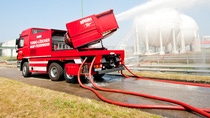Sustainability
Prevention
For us, emergency response means being prepared at all times and at all locations for a possible incident at our company. This applies both to production as well as our transport chains.

We assess all sites around the world on the basis of a structured and transparent procedure. This allows us to implement measures which meet local requirements and provide a comparable level of safety. For example, this classification results in the drawing up of specific emergency response plans for our production plants, the alarm plans plus the specification of fire and explosion protection facilities. The organizational emergency response measures are also described.
A key feature for the success of our emergency response concepts in the event of an incident are regular practical testing. We therefore check our emergency systems at regular intervals and run exercises on the procedures with employees, contractors and official authorities.
Given our many years of experience in the safe handling of chemicals, many organizations come to us for advice. This is why we belong to networks that supply information and assist in emergencies. These include the German Transport Accident Information and Emergency Response System (TUIS) and the International Chemical and Environmental (ICE) initiative. We are using the experience accumulated here to establish similar systems in other. For several years, for example, we introduced a regional risk matrix in Asia, which is used to define requirements for emergency response measures and accident information.
In addition, we have an international network of emergency assistance and emergency response centers, primarily in Europe and in North America, South America, and also at important production sites in Asia.